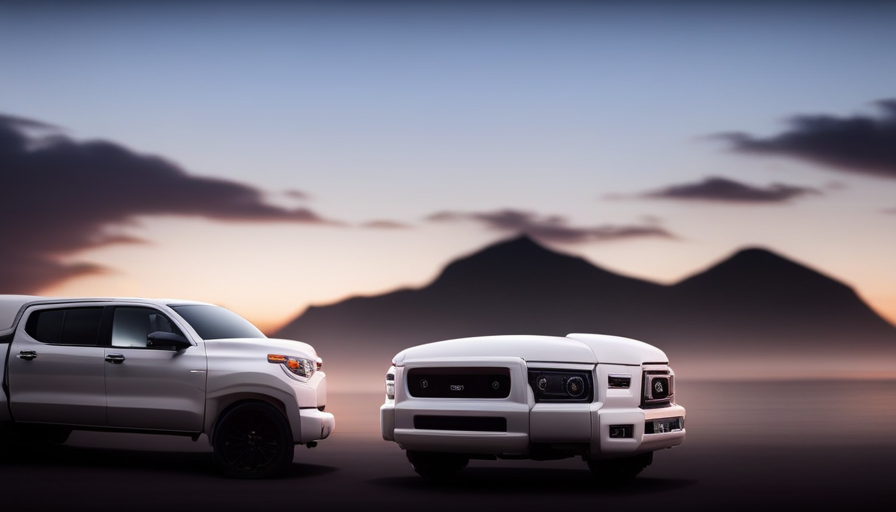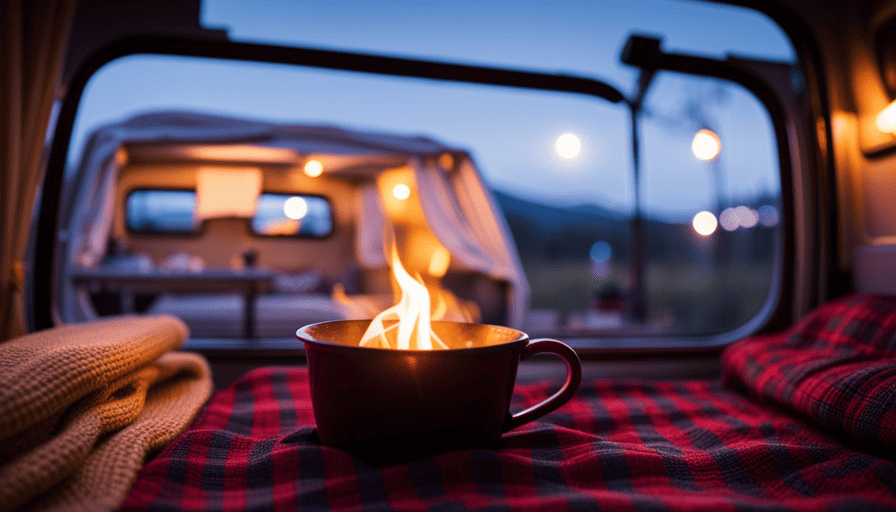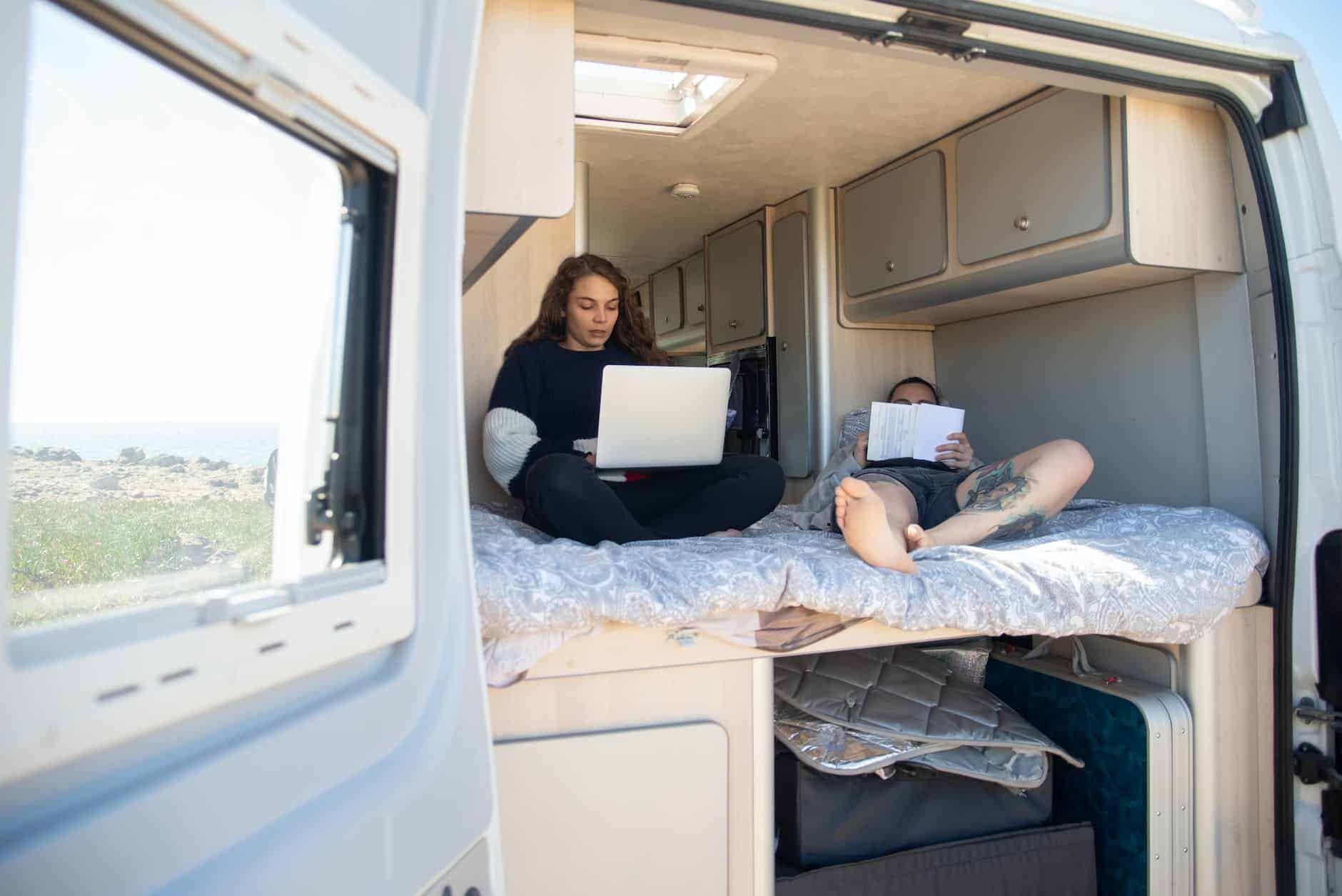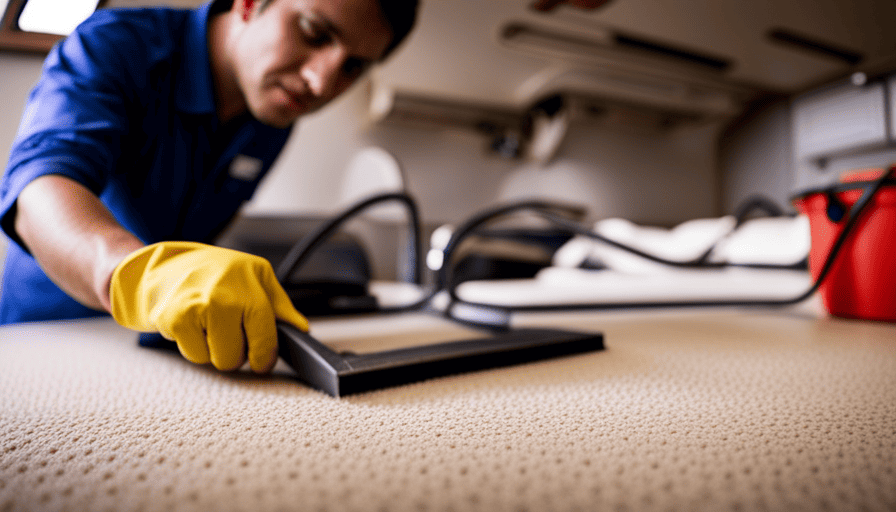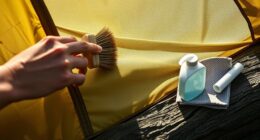Camping in the winter can be an exciting experience, but it’s important to recognize the challenges of staying warm in extremely cold conditions. After spending time in the frigid wilderness with my trusty camper, I’ve learned valuable tips for keeping cozy as the temperature decreases.
In fact, I have discovered some ingenious techniques that will make you feel like you’re lounging on a tropical beach, even when surrounded by snow-covered pines.
Now, I’m not claiming to be a magician, but I do have a few tricks up my sleeve that will turn your camper into a toasty haven. From insulating your camper properly to layering up with warm clothing, I’ve got you covered.
And don’t worry, I won’t leave you out in the cold when it comes to staying well-fed and hydrated. So, grab your favorite mug of hot cocoa, and let’s dive into the ultimate guide on how to keep your camper warm in winter. Trust me, you’ll thank me later when you’re snug as a bug in a rug despite the icy temperatures outside.
Key Takeaways
- Insulation is essential for warmth in winter camping
- Portable electric heaters and blankets provide instant and customizable warmth
- Layering up with warm clothing and accessories is crucial
- Sheltered parking and proper ventilation are important for insulation and staying dry.
Insulate Your Camper Properly
Make sure you’re using proper insulation to keep your camper nice and toasty during those cold winter nights. Camper insulation tips are essential for ensuring that you stay warm and comfortable inside your camper when the temperatures drop.
One of the main benefits of insulating your camper is that it helps to trap heat inside, preventing it from escaping and keeping the cold air out. This not only helps to maintain a cozy environment but also saves energy by reducing the need for constant heating.
To effectively insulate your camper, start by sealing any gaps or cracks in the walls, windows, and doors. This will prevent cold drafts from entering and warm air from escaping. You can also add insulation to the walls, roof, and floor of your camper using materials like foam boards or reflective insulation. These materials provide an extra layer of protection against the cold.
Additionally, consider using thermal curtains or window coverings to further insulate your camper. These curtains help to block out drafts and keep the heat inside. They’re easy to install and can make a significant difference in maintaining a warm interior.
By properly insulating your camper, you can create a cozy and warm space to enjoy during the winter months. Once your camper is well-insulated, you can move on to the next step of keeping warm – using a space heater or a portable electric blanket.
Use a Space Heater or Portable Electric Blanket
Snuggle up in the cozy embrace of a space heater or portable electric blanket to transform your chilly camping experience into a toasty oasis. When it comes to staying warm in your camper during winter, these handy devices are a game-changer. Here are four reasons why a portable electric heater or electric blanket should be a part of your essential winter camping gear:
-
Instant warmth: With just a flick of a switch, a portable electric heater can quickly fill your camper with comforting heat, making it feel like a cozy cabin in the woods.
-
Customizable temperature: Most electric heaters come with adjustable settings, allowing you to find the perfect level of warmth for your comfort. You can easily regulate the temperature to suit your preferences.
-
Energy efficiency: Many portable electric heaters are designed to be energy-efficient, ensuring that you stay warm without draining your camper’s power supply. Look for models with energy-saving features.
-
Portable convenience: Whether you choose a space heater or an electric blanket, both options are portable and easy to carry. You can move them around your camper as needed to target specific areas or even take them outside for extra warmth.
By incorporating a portable electric heater or electric blanket into your winter camping gear, you’ll be well on your way to staying snug and cozy. Layer up with warm clothing and you’ll be ready to brave the winter weather.
Layer Up with Warm Clothing
Bundle yourself up in layers of cozy clothing, and you’ll feel like you’re wrapped in a comforting hug as you brave the chilly winter air. When it comes to winter camping, it’s essential to choose the right gear to keep yourself warm and comfortable throughout the night.
Start with a good base layer made of moisture-wicking material such as merino wool or synthetic fabrics. These materials will keep you dry by wicking away sweat from your body.
Next, add an insulating layer like a fleece or down jacket to trap heat close to your body.
Finally, don’t forget a waterproof and windproof outer layer to protect you from the elements.
Accessories such as hats, gloves, and thick socks are also crucial to keep extremities warm. Opt for insulated and waterproof options to ensure maximum warmth and protection. Additionally, make sure to wear thermal underwear and warm, comfortable boots to keep your feet cozy.
By layering up with warm clothing, you’ll be well-prepared for winter camping. However, if you want an extra boost of warmth, consider using hot water bottles or heating pads. These can be placed inside your sleeping bag to provide targeted heat to specific areas of your body.
With the right winter camping essentials and gear, you’ll be able to enjoy a comfortable and cozy camping experience even in the coldest of temperatures.
Use Hot Water Bottles or Heating Pads
When the winter chill bites, let the comforting warmth of hot water bottles or heating pads embrace you, turning your icy tent into a cozy haven. Here are four alternatives to hot water bottles and the benefits of using heating pads:
-
Electric Blankets: These’re a great alternative to hot water bottles as they provide a consistent and adjustable heat. Simply plug it in, set your desired temperature, and snuggle up!
-
Hand Warmers: These small, portable heating devices’re perfect for keeping your hands and feet warm during those chilly nights. They’re easy to use and can provide hours of heat.
-
Heated Sleeping Bags: These innovative sleeping bags have built-in heating elements that can keep you warm all night long. They’re a bit pricier, but definitely worth the investment for those who camp in extreme cold weather.
-
Heated Seats: If you’re camping in a vehicle, consider using heated seats to keep yourself warm. Many cars and RVs’re equipped with this feature, making it a convenient option.
Using heating pads also has its benefits. They provide targeted heat to specific areas of your body, helping to soothe sore muscles and promote relaxation. Additionally, heating pads’re reusable and can be used for multiple camping trips.
Now that you know about hot water bottle alternatives and the benefits of heating pads, let’s move on to the next section about investing in a quality sleeping bag.
Invest in a Quality Sleeping Bag
To truly embrace the winter wilderness, you’ll want to ensure you invest in a top-notch sleeping bag. Choosing the right sleeping bag is crucial for staying warm and comfortable during those cold nights under the stars.
Look for a bag that is specifically designed for winter camping and has a temperature rating suitable for the coldest temperatures you expect to encounter. Insulation is key, so opt for a bag with high-quality down or synthetic insulation that’ll provide excellent warmth retention.
When it comes to choosing a tent, look for one that’s specifically designed for winter camping. A four-season tent’ll offer better protection against the elements and provide additional insulation. Make sure the tent is made from a durable and waterproof material to keep you dry and protected from snow and wind.
Using a camping hammock can also help keep you warm in winter. By suspending your sleeping bag above the ground, you can minimize heat loss caused by contact with the cold ground. Choose a hammock made from insulating materials and consider adding an underquilt or sleeping pad for extra insulation.
To ensure your camper stays warm during winter camping trips, it’s important to park it in sheltered areas. This can include parking near trees or other natural windbreaks that can help block out the cold wind and provide some additional insulation.
Park Your Camper in Sheltered Areas
Find a cozy spot to park your camper, nestled among the trees or behind natural windbreaks, to shield yourself from the harsh winter elements and create a snug oasis in the midst of the wilderness.
When it comes to winter camping, finding a sheltered parking spot is crucial for your safety and comfort. Here are five reasons why sheltered parking is essential for winter camping:
-
Protection from strong winds: Parking your camper in a sheltered area will shield it from strong gusts of wind that can make the inside feel chilly and drafty.
-
Reduced heat loss: A sheltered parking spot can help prevent heat loss from your camper, keeping the interior warmer for longer.
-
Increased privacy: Being parked in a secluded and sheltered area provides a sense of privacy and tranquility, allowing you to fully enjoy your winter camping experience.
-
Minimized snow accumulation: A sheltered parking spot can help minimize snow accumulation on your camper, making it easier to clear off and maintain.
-
Enhanced insulation: Parking your camper in a sheltered area can provide an additional layer of insulation, helping to retain heat and keep you cozy throughout the night.
By finding the perfect spot to park your camper, you can ensure a warm and comfortable winter camping experience.
Now, let’s move on to the next section on how to cook warm meals and drinks to keep yourself cozy.
Cook Warm Meals and Drinks
When it comes to keeping warm during winter camping trips, one of the best ways is to cook warm meals and drinks. I always make sure to bring a portable stove or camping grill, which allows me to easily cook up hot meals like soups, stews, and chili.
And let’s not forget about hot drinks! I love making a fresh cup of tea or cocoa to warm up from the inside out.
Use a Portable Stove or Camping Grill
Stay cozy during your winter camping adventures by using a portable stove or camping grill to warm up your delicious meals. Here are some tips to ensure portable stove safety and alternative heating methods:
-
Choose a portable stove or camping grill that’s specifically designed for outdoor use and has safety features such as a stable base and flame control.
-
Set up your stove or grill in a well-ventilated area away from flammable materials like tents or dry leaves.
-
Always keep a fire extinguisher or bucket of water nearby in case of emergencies.
-
Use alternative heating methods like hot rocks or a candle-powered heater as a backup option.
By following these safety guidelines, you can enjoy warm and hearty meals even in the coldest winter camping trips.
Once you’ve satisfied your hunger, it’s time to make hot drinks like tea or cocoa to keep you warm throughout the day.
Make Hot Drinks like Tea or Cocoa
Indulge in the comforting warmth of a steaming cup of tea or cocoa during your winter camping adventure, and discover how it enhances the enjoyment of your outdoor experience. When the temperature drops, there’s nothing quite like holding a hot beverage in your hands, feeling the heat seep into your body, and warming you from the inside out. To fully appreciate the benefits of herbal tea for keeping warm in winter, imagine yourself huddled by the campfire, sipping a fragrant blend of chamomile and cinnamon. It not only warms you up but also relaxes your mind after a long day of outdoor activities. And for those with a sweet tooth, get creative with hot cocoa recipes. From peppermint mocha to salted caramel, the options are endless. So, wrap your hands around a cozy mug, savor the flavors, and let the warmth fuel your next winter adventure. As you continue reading, you’ll discover more ways to keep active and move around without sacrificing comfort.
Keep Active and Move Around
Toasty tip: Don’t forget to keep on the move! When camping in the winter, it’s crucial to stay physically active to keep warm. Engaging in winter outdoor activities not only helps generate body heat but also boosts blood circulation, which is essential for maintaining a comfortable body temperature.
Here are some activities that can keep you warm during your winter camping adventure:
-
Hiking: Exploring the snowy trails not only provides a scenic experience but also keeps your body moving and generates heat.
-
Snowshoeing: This low-impact activity is a great way to explore the winter wonderland while keeping your heart rate up and your body warm.
-
Sledding: Whether you prefer traditional sleds or inflatable tubes, sliding down the snowy slopes is not only fun but also a great way to stay active and warm.
-
Ice skating: Gliding over frozen lakes or rinks is not only a delightful winter activity but also an excellent way to keep your body in motion and generate heat.
Remember, staying active in the cold weather is essential for keeping warm while camping. So lace up your boots, grab your sled, and hit the winter wonderland!
Next, let’s discuss the importance of using thermal or reflective blankets to stay cozy throughout the night.
Use Thermal or Reflective Blankets
Once you’ve finished exploring the snowy trails and gliding over frozen lakes, snuggling up with a thermal or reflective blanket will ensure a cozy night of sleep during your winter camping adventure. These alternative insulation options are essential to keep campers warm when the temperatures drop.
Thermal blankets are designed to retain body heat and provide insulation, while reflective blankets are made with a material that reflects heat back towards the body. Both options are lightweight and compact, making them ideal for backpacking trips.
When choosing a thermal or reflective blanket, look for one that’s made with high-quality materials and is large enough to cover your entire body. It’s also important to consider the blanket’s weight and packability, as you’ll likely be carrying it in your backpack. Additionally, make sure to read reviews and consider the experiences of other winter campers to find the best option for your needs.
In terms of winter camping safety tips, using a thermal or reflective blanket can help prevent hypothermia and keep you warm throughout the night. However, it’s important to remember that these blankets aren’t a substitute for proper clothing and gear. Layering your clothing, wearing a hat and gloves, and using a sleeping bag rated for cold temperatures are all crucial for staying warm in winter conditions.
As we transition into the next section about staying dry and avoiding moisture, it’s important to note that these blankets can also help wick away moisture from your body, keeping you dry and comfortable.
Stay Dry and Avoid Moisture
To ensure a comfortable and cozy winter camping experience, it’s crucial to stay dry and steer clear of any unwanted moisture, like a determined hiker avoiding slippery slopes. Winter camping can be challenging, but with the right precautions, it can also be an exhilarating adventure.
Here are some practical tips to prevent condensation and choose the right bedding for a warm and dry night under the stars:
-
Ventilation is key: Proper airflow is essential to prevent condensation inside your tent. Make sure to open vents and windows slightly to allow for air circulation while still maintaining warmth.
-
Invest in a quality sleeping bag: Look for a sleeping bag that provides adequate insulation and has a water-resistant outer layer. Consider using a sleeping bag liner for extra warmth and moisture protection.
-
Use a waterproof groundsheet: Placing a waterproof groundsheet between your sleeping bag and the tent floor will help keep moisture at bay.
-
Opt for moisture-wicking clothing: Wearing moisture-wicking base layers will help regulate body temperature and keep you dry throughout the night.
-
Choose the right sleeping pad: Insulated sleeping pads provide an extra layer of warmth and insulation between you and the cold ground.
By following these tips and taking the necessary precautions, you can stay dry and comfortable during your winter camping adventures. So go ahead, embrace the winter wonderland and create lasting memories while staying warm and cozy.
Frequently Asked Questions
Are there any specific brands or models of space heaters or portable electric blankets that are recommended for keeping a camper warm in winter?
I recommend looking into brands such as Dyson, De’Longhi, and Lasko for space heaters. These brands offer a range of models that are reliable and efficient in keeping a camper warm during winter.
As for portable electric blankets, Sunbeam and Biddeford are highly recommended. They’re known for their quality and ability to provide warmth and comfort in a compact and portable design.
How do I properly insulate the windows and doors of my camper to prevent cold air from entering?
To properly insulate the windows of my camper and prevent cold air from entering, I recommend using window insulation film or thermal curtains. These can create a barrier between the window and the interior, reducing heat loss.
Additionally, weatherstripping around the window frames can help seal any gaps. As for door insulation, using draft stoppers or weatherstripping along the edges can effectively keep cold air out.
Can I use a regular sleeping bag or do I need to invest in a specific winter sleeping bag for camping in cold temperatures?
For camping in cold temperatures, investing in a specific winter sleeping bag is the better choice. Regular sleeping bags are not designed to provide the necessary insulation and warmth needed in freezing conditions.
Winter sleeping bags are specifically designed with thicker insulation and advanced materials to keep you comfortable and warm in low temperatures. So, to ensure a cozy and comfortable camping experience, it’s worth investing in a winter sleeping bag that is specifically designed for cold weather conditions.
Is it safe to use a propane heater or stove inside a camper to generate heat?
Using a propane heater or stove inside a camper to generate heat is like playing with fire. It’s not safe and can lead to carbon monoxide poisoning or even a deadly fire. Instead, consider alternative heating methods.
Invest in a good quality winter sleeping bag and layer up with warm clothing. Use insulated mats and blankets to trap heat. And don’t forget to insulate your camper properly to keep the cold air out. Safety should always be the top priority.
Are there any tips for preventing condensation and moisture buildup inside the camper during winter camping trips?
To reduce condensation and moisture buildup in a camper during winter camping, I recommend a few tips.
Firstly, ensure proper ventilation by cracking windows or using vents. This allows moisture to escape and fresh air to circulate.
Secondly, use moisture-absorbing materials like silica gel packs or dehumidifiers. These help to keep the air dry inside the camper.
Lastly, when drying wet clothes, hang them outside if possible or use a clothesline inside with good airflow to prevent excess moisture.
Are the Methods to Keep a Camper Warm in Winter the Same as Keeping it Cool in Summer?
Are the methods for keeping your camper cool in summer the same as keeping it warm in winter? While the end goals thermal comfort are similar, the approaches differ. In summer, using awnings, reflective covers, and shading can help, while in winter, you’ll want to insulate, seal drafts, and use heating devices to stay warm.
Can the same methods used to keep a camper cool in summer also be used to keep it warm in winter?
Yes, the same methods used to keep a camper cool in summer can also be used to keep it warm in winter. By insulating the camper, using thermal curtains, and sealing any drafts, you can effectively trap heat inside. Additionally, using a space heater or a portable radiator can help to maintain a comfortable temperature inside the camper. Mastering how to stay cool camper in summer can be equally beneficial for staying warm in winter.
Conclusion
In conclusion, keeping warm during winter camping may seem like a daunting task, but fear not! With the right techniques and equipment, you can turn your camper into a cozy haven.
From insulating properly to layering up with warm clothing, there are plenty of ways to stay toasty. And hey, who needs a regular sleeping bag when you can invest in a top-notch, super-warm one?
So go ahead, brave the winter chill with confidence, knowing that you have the knowledge and experience to conquer the cold!




